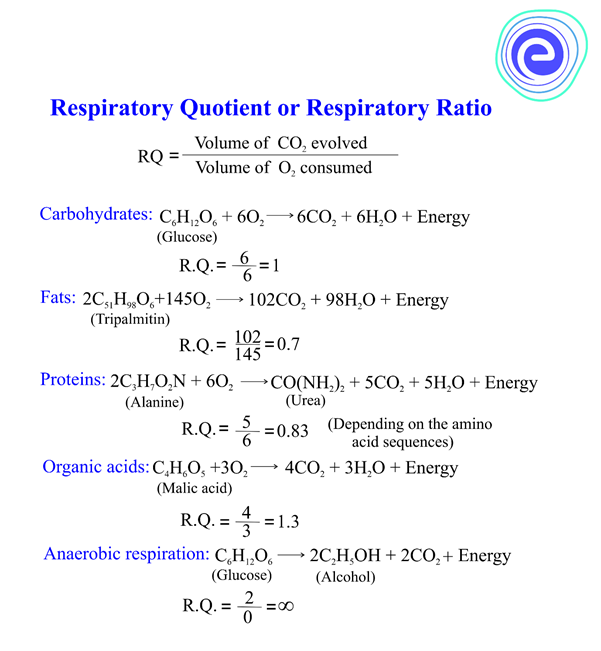- Written By
Manisha Minni
- Last Modified 23-03-2025
Respiratory Quotient – Definition, Factors & Significance
RQ stands for Respiratory Quotient, which is also known as Respiratory Ratio. It is defined as the ratio of carbon dioxide evolved to oxygen absorbed in respiration per unit time per unit weight at standard temperature and pressure.
The respiratory substrate is broken down to release energy in the process of respiration. Aerobic and anaerobic respiration are the main two types of respiration that occur in the presence or absence of molecular oxygen. Glucose is the most common respiratory substrate present in plants. Let us learn about the respiratory quotient in detail.
Respiratory Quotient Definition
During Aerobic respiration, O2 is consumed, and CO2 is released. The ratio of CO2 evolved to the amount of O2 consumed in respiration is called the respiratory quotient (R.Q.).
\({\rm{R}}{\rm{.Q}}{\rm{. = }}\frac{{{\rm{Vol}}{\rm{.\;of\;C}}{{\rm{O}}_{\rm{2}}}{\rm{\;evolved}}}}{{{\rm{Vol}}{\rm{.\;of\;}}{{\rm{O}}_{\rm{2}}}{\rm{\;consumed}}}}\)
Respirometer is an instrument used for measuring the rate of respiration as well as R.Q. The R.Q. for a mixed diet (carbohydrates, fats, and proteins) is about 0.85.
Factors of Respiratory Quotient
The value of R.Q. depends on many factors that are mentioned below:
1. Nature of the respiratory substrate.
2. The amount of oxygen present in the respiratory substrate.
3. The extent to which the respiratory substrate is broken down.
4. The changes in the oxidation and reduction levels of the respiratory substrates.
5. The value of R.Q. depends on whether all oxygen being absorbed is used during respiration or other purposes.
R.Q. Value in Different Substrates
The respiratory quotient values depend on different respiratory substrates, and its oxidation are as follows:
1. Respiratory Quotient of Carbohydrates: The carbohydrates like glucose, fructose, starch, sucrose, etc., are the main respiratory substrate in plants. The complete oxidation of hexose sugars like glucose or fructose during aerobic respiration results in an equal ratio of \(\rm{CO}_2\) release and consumption of \(\rm{O}_2\). In this case, the value of Respiratory Quotient (R.Q.) is found to be one of unity.
\({\text{C}}_{\text{6}}{\text{H}}_{{\text{12}}}{\text{O}}_{\text{6}}{\text{ + 6}}{\text{O}}_{\text{2}}\left( {{\text{Glucose}}} \right) \to {\text{6C}}{\text{O}}_{\text{2}}{\text{ + 6}}{\text{H}}_{\text{2}}{\text{O + Energy}}\)
\({\rm{R}}{\rm{.Q}}{\rm{. = }}\frac{{{\rm{Vol}}{\rm{.\;of\;C}}{{\rm{O}}_{\rm{2}}}}}{{{\rm{Vol}}{\rm{.\;of\;}}{{\rm{O}}_{\rm{2}}}}}{\rm{ = }}\frac{{\rm{6}}}{{\rm{6}}}{\rm{ = 1\;}}\) or unity.
2. Respiratory Quotient of Fats: Fats are usually present in seeds as storage food in plants. Fats need more amount of \(\rm{O}_2\) for their oxidation as compared to other substrates. The Respiratory Quotient (R.Q.) value is less than one or unity in the aerobic respiration of fats.
\({\text{2}}{{\text{C}}_{{\text{51}}}}{{\text{H}}_{{\text{98}}}}{{\text{O}}_{\text{6}}}\left( {{\text{Tripalmitin}}} \right){\text{ + 145}}{{\text{O}}_{\text{2}}} \to {\text{102C}}{{\text{O}}_{\text{2}}}{\text{ + 98}}{{\text{H}}_{\text{2}}}{\text{O + Energy}}\)
\({\rm{R}}{\rm{.Q}}{\rm{. = }}\frac{{{\rm{Vol}}{\rm{.\;of\;C}}{{\rm{O}}_{\rm{2}}}}}{{{\rm{Vol}}{\rm{.\;of\;}}{{\rm{O}}_{\rm{2}}}}}{\rm{ = }}\frac{{{\rm{102}}}}{{{\rm{145}}}}{\rm{ = 0}}{\rm{.7}}\) (less than one)
3. Respiratory Quotient of Proteins and their derivatives: The amino acids are the building blocks of proteins. Proteins act as respiratory substrates under certain specific conditions, like when the cells are going to starvation. Protein structures vary with variations in amino acid sequence. So, the value of R.Q. also varies from 0.8-0.9 depending upon the structure of different amino acids.
\(2{{\text{C}}_3}{{\text{H}}_7}{{\text{O}}_2}{\text{N}}({\text{Alanine}}) + 6{{\text{O}}_2} \to {\text{CO}}{\left( {{\text{N}}{{\text{H}}_2}} \right)_2}({\text{Urea}}) + 5{\text{C}}{{\text{O}}_2} + 5{{\text{H}}_2}{\text{O}} + {\text{Energy}}\)
\({\rm{R}}{\rm{.Q}}{\rm{. = }}\frac{{{\rm{Vol}}{\rm{.\;of\;C}}{{\rm{O}}_{\rm{2}}}}}{{{\rm{Vol}}{\rm{.\;of\;}}{{\rm{O}}_{\rm{2}}}}}{\rm{ = }}\frac{{\rm{5}}}{{\rm{6}}}{\rm{ = 0}}{\rm{.83\;}}\) (less than one)
4. Respiratory Quotient of Organic Acids: When the organic acids are oxidised in respiration, the value of R.Q. is greater than one as organic acids are rich in \(\rm{O}_2\) and require less \(\rm{O}_2\) for their oxidation.
\({{\text{C}}_4}{{\text{H}}_6}{{\text{O}}_5}\left( {{\text{Malic}}\,{\text{acid)}} + 3{{\text{O}}_2} \to 4{\text{C}}{{\text{O}}_2} + 3{{\text{H}}_2}{\text{O}} + } \right.{\text{Energy}}\)
\({\rm{R}}{\rm{.Q}}{\rm{. = }}\frac{{{\rm{Vol}}{\rm{.\;of\;C}}{{\rm{O}}_{\rm{2}}}}}{{{\rm{Vol}}{\rm{.\;of\;}}{{\rm{O}}_{\rm{2}}}}}{\rm{ = }}\frac{{\rm{4}}}{{\rm{3}}}{\rm{ = 1}}{\rm{.3\;}}\) (more than one)
5. Respiratory Quotient of Succulents: In some succulent plants like Opuntia, Bryophyllum, etc., carbohydrates are not oxidised completely. Due to incomplete oxidation, organic acids are produced in the dark without the evolution of \(\rm{CO}_2\). Stomata remain open during the night in succulent plants. So, at night when oxygen is absorbed, the carbohydrates are partially oxidised to organic acids without the formation of \(\rm{CO}_2\). So, the value of R.Q. remains zero. Even during the daytime, the value of RQ remains zero because the \(\rm{CO}_2\) released during respiration is used up as a substrate for photosynthesis.
\(2{{\text{C}}_6}{{\text{H}}_{12}}{{\text{O}}_6}{\text{(Glucose)}} + 3{{\text{O}}_2} \to 3{{\text{C}}_4}{{\text{H}}_6}{{\text{O}}_5}{\text{(Malic}}\,{\text{acid)}} + 3{{\text{H}}_2}{\text{O}} + {\text{Energy}}\)
\({\rm{R}}{\rm{.Q}}{\rm{. = }}\frac{{{\rm{Vol}}{\rm{.\;of\;C}}{{\rm{O}}_{\rm{2}}}}}{{{\rm{Vol}}{\rm{.\;of\;}}{{\rm{O}}_{\rm{2}}}}}{\rm{ = }}\frac{{\rm{0}}}{{\rm{3}}}{\rm{ = 0\;}}\) (zero)
6. In anaerobic respiration, due to the absence of \(\rm{O}_2\), \(\rm{CO}_2\) is generally produced. Carbohydrate is the usual substrate. So, the value of R.Q. remains infinite.
\({{\text{C}}_6}{{\text{H}}_{12}}{{\text{O}}_6}({\text{Glucose}}) \to 2{\text{C}}{{\text{O}}_2} + 2{{\text{C}}_2}{{\text{H}}_5}{\text{OH(Alcohol)}}\)
\({\rm{R}}{\rm{.Q}}{\rm{. = }}\frac{{{\rm{Vol}}{\rm{.\;of\;C}}{{\rm{O}}_{\rm{2}}}}}{{{\rm{Vol}}{\rm{.\;of\;}}{{\rm{O}}_{\rm{2}}}}}{\rm{ = }}\frac{{\rm{2}}}{{\rm{0}}}{\rm{ = }}\infty {\rm{\;}}\) (infinity)
Fig: The Value of Respiratory Quotient in Different Substrates
Significance of Respiratory Quotient
The significance of Respiratory Quotient is given below:
(i) R.Q. helps in determining the type of respiration being performed.
(ii) R.Q. gives some information about the significant transformation of food materials.
(iii) The nature of the respiratory substrate that oxidized the transformation of the substrate and the biochemical mechanism of respiration can be found from the results of R.Q.
(iv) R.Q. helps in knowing the metabolic rate.
(v) R.Q. helps determine various pathological conditions like acidosis, alkalosis, etc.
(vi) R.Q. help in the prediction of weight gain in non-insulin-dependent diabetic patients.
(vii) R.Q. has great application in severe chronic obstructive pulmonary disease cases.
(viii) R.Q. has great application in severe cases of chronic obstructive pulmonary disease.
(ix) R.Q. gives information whether the cells or bodies are under normal nutrition or starvation.
Summary
The ratio of \(\rm{CO}_2\) evolved to the amount of \(\rm{O}_2\) consumed in respiration is called the respiratory quotient (R.Q.). The value of R.Q. depends on different respiratory substrates and their oxidation. For example, if the value of R.Q. is one, it indicates that carbohydrates are being oxidized during respiration. Similarly, if the value is less than one, organic matter like fats constitutes the respiratory substrates. R.Q. helps in the determination of various pathological conditions like acidosis, alkalosis, etc.
FAQs
Q.1. What is a Respiratory Quotient?
Ans: During aerobic respiration, \(\rm{O}_2\) is consumed, and \(\rm{CO}_2\) is released. The ratio of \(\rm{CO}_2\) evolved to the amount of \(\rm{O}_2\) consumed in respiration is called the respiratory quotient (R.Q.).
Q.2. What will be the R.Q? if tripalmitin is used as a substrate in respiration?
Ans: Since tripalmitin is a lipid, the R.Q. value will be 0.7.
Q.3. What is the Respiratory Quotient of carbohydrates?
Ans: The respiratory quotient of carbohydrates is known to be 1.
Q.4. Write down the significance of R.Q?
Ans: The significance of R.Q. are given below:
(i) R.Q. having great application in severe cases of chronic obstructive pulmonary disease.
(ii) R.Q. helps in determining the type of respiration being performed.
Q.5. Mention the respiratory quotient of the succulents.
Ans: The respiratory quotient of the succulents is zero.
Now that you have a detailed article on Respiratory Quotient, we hope you study well. If you get stuck somewhere do let us know in the comments sections. We will get back to you at the earliest.









































